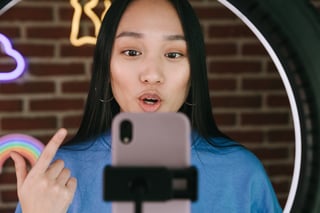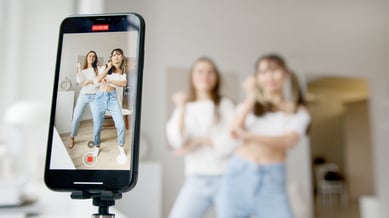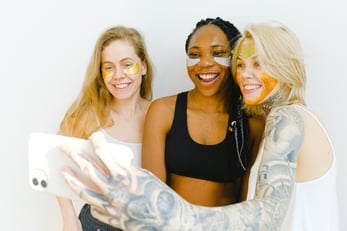The Social Media Dichotomy: Gen Z's Friend or Foe?
 Generation Z has a love-hate relationship with social media. Having grown up as the first official Digital Natives, they are extremely familiar with and close to the digital world—sometimes too close—and they’re definitely feeling it. With the rise of ecommerce, social media influencers, and now content creators, Gen Zers are becoming more savvy at spotting false advertising and unrealistic expectations, especially around beauty ideals. Here’s how brands can create a more authentic, genuine experience for their young consumers on social media, and help them fight the pressures to fit into pervading beauty standards.
Generation Z has a love-hate relationship with social media. Having grown up as the first official Digital Natives, they are extremely familiar with and close to the digital world—sometimes too close—and they’re definitely feeling it. With the rise of ecommerce, social media influencers, and now content creators, Gen Zers are becoming more savvy at spotting false advertising and unrealistic expectations, especially around beauty ideals. Here’s how brands can create a more authentic, genuine experience for their young consumers on social media, and help them fight the pressures to fit into pervading beauty standards.
Unfilter your marketing
 In the early social media days, filters were harmless tools to make pictures look more artistic or professional. Present-day filters on Instagram and Snapchat are less obvious and more insidious, with many mimicking popular surgical and cosmetic face alteration procedures, like smaller noses, slimmer chins and cheeks, and smoothed-over skin. Beauty filters even exist now on teleconferencing programs like Zoom and Google Meets. They’ve become so problematic that countries, like the United Kingdom, are enacting laws to combat them, requiring influencers to disclose when their photos have been altered.
In the early social media days, filters were harmless tools to make pictures look more artistic or professional. Present-day filters on Instagram and Snapchat are less obvious and more insidious, with many mimicking popular surgical and cosmetic face alteration procedures, like smaller noses, slimmer chins and cheeks, and smoothed-over skin. Beauty filters even exist now on teleconferencing programs like Zoom and Google Meets. They’ve become so problematic that countries, like the United Kingdom, are enacting laws to combat them, requiring influencers to disclose when their photos have been altered.
Enter the concepts of Snapchat Dysmorphia and Instagram Face, the idea that these beautified filters that alter our faces to be more conventionally attractive is leading to lower self-esteem and a greater desire for surgical enhancements. Our 2021 Generation Wattpad survey on Female Empowerment shows that 41% of Gen Z believe that their peers are more open to cosmetic surgery because of seeing their altered faces in filters, despite 79% of them saying they want to see more natural, unretouched images of people in brand marketing and advertising.
Creating filters is a great way for brands to engage with their consumers. MAC Cosmetics is known for creating engaging custom filters, with a recent one allowing beauty lovers to virtually try on their new lipstick colors on Snapchat. Adidas Originals jumped on the trend, too, launching a retro filter on Instagram to coincide with the re-release of an older shoe model. At Wattpad, we’ve built Snapchat Lenses to help readers explore new genres, too. Brands can engage with their consumers in a genuine way through the use of filters—just leave the face-altering additions alone. Better yet, make a point of telling your Gen Z audience that your filters won’t alter their faces, and watch it go viral.
Work with nano-influencers
 The days of follower counts being the most important factor of influencing are over. Gen Z aren’t interested in buying disingenuously marketed products or services by influencers with millions of followers. Gen Z shoppers are smart—31% of Wattpadders from our 2022 Pulsecheck survey said that influencer marketing is untrustworthy, especially in spaces that are oversaturated with branded content and sponsored posts. While the macro-influencer once had sway, the baton has been passed down to influencers with minimal followers, who have influence within their communities and can better reach the regular, everyday person.
The days of follower counts being the most important factor of influencing are over. Gen Z aren’t interested in buying disingenuously marketed products or services by influencers with millions of followers. Gen Z shoppers are smart—31% of Wattpadders from our 2022 Pulsecheck survey said that influencer marketing is untrustworthy, especially in spaces that are oversaturated with branded content and sponsored posts. While the macro-influencer once had sway, the baton has been passed down to influencers with minimal followers, who have influence within their communities and can better reach the regular, everyday person.
Statistics show that nano-influencers have the highest level of engagement, because they often have real-life relationships with their followers. La Croix, Banana Republic, Glossier and Starbucks are all examples of brands that work successfully with nano-influencers across their social media channels. It gives shoppers the impression that real, everyday people like them, purchase from them and use their services.
Match Gen-Z's energy

Generation Z champions authenticity and transparency. Marketing to Gen Z is about feeding them content that feels (and is) trustworthy and real. Leaning away from filtered, airbrushed imagery, and working with genuine nano-influencers will appeal to their community-driven minds and desire for something different. While a smaller reach and perhaps “less aesthetic” look can be a downfall, the payoff is building authentic brand loyalty and trust—and that pays for itself.
Learn more about building safe online communities for Gen Z.